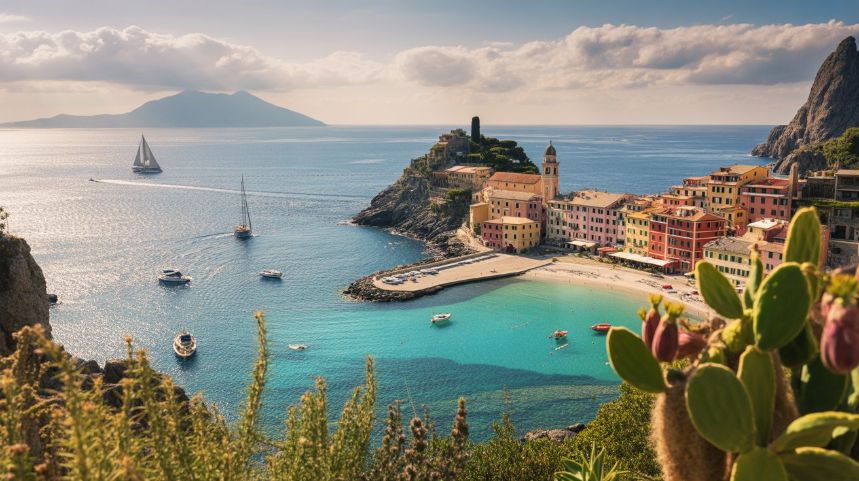
Top 16 Most Beautiful Islands in Italy to Visit in 2025
When travelers go back to their minds about Italy, scenes of Rome’s Colosseum, Florence’s Renaissance masterpieces, and Venice’s canals often come first. But Italy is more than a nation of culture and history, it’s also the location of some of the Mediterranean’s most stunning islands. With more than 450 islands, Italy has everything from high-end hideaways for the jet set to volcanic explorations, ancient fishing ports, and secluded paradises that seem like another world.
In 2025, Italian islands are becoming even more attractive thanks to sustainable tourism initiatives, improved ferry connections, and a renewed focus on authentic local experiences. Whether you’re after Caribbean-style beaches in Sardinia, the glamour of Capri, the volcanic spectacle of Stromboli, or the colorful charm of Procida, there’s an island in Italy that will feel tailor-made for your journey.
Top 17 Most Beautiful Islands in Italy
This blog explores the 16 most stunning Islands in Italy, providing not just inspiration but also tips, so you can book your own island getaway with confidence.
1. Sardinia – The Emerald Coast Paradise
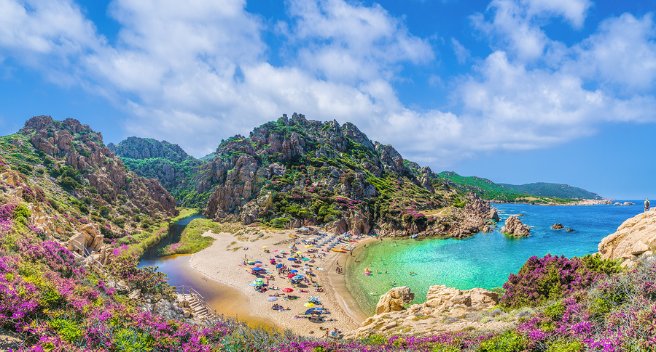
Sardinia (Sardegna) is the second-largest island in Italy and one of the most diverse in landscapes and culture. From the jet-set Costa Smeralda to rugged mountains, prehistoric nuraghe ruins, and unspoiled villages, Sardinia feels almost like a country of its own. Known for its emerald-green waters, white sandy beaches, luxury resorts, and ancient traditions, it is an island that blends glamour with authenticity.
Best Things to Do in Sardinia
- Costa Smeralda (Emerald Coast): A glamorous stretch with luxury yachts, boutique hotels, and turquoise coves. Porto Cervo is the chic hub.
- Maddalena Archipelago: A UNESCO-protected group of islands, perfect for sailing, snorkeling, and pink-sand beaches.
- Nuraghe Ruins: Visit Su Nuraxi di Barumini, a UNESCO World Heritage site, to discover Sardinia’s unique Bronze Age towers.
- Alghero’s Old Town: A Catalan-Gothic city with cobblestone streets, seafood restaurants, and nearby Neptune’s Grotto.
- Cagliari: The capital city, with its medieval Castello district and lively markets.
- Hiking: Explore Gennargentu National Park or the dramatic Su Gorropu Gorge, one of Europe’s deepest canyons.
Top Beaches in Sardinia
Sardinia is home to some of the best beaches in Europe:
- La Pelosa (Stintino): Caribbean-like white sand and shallow turquoise waters.
- Cala Luna: A crescent-shaped beach framed by caves, accessible by boat or hike.
- Cala Mariolu & Cala Goloritzé (Baunei coast): Famous for their dramatic limestone cliffs and crystal water.
- Spiaggia del Principe (Costa Smeralda): A favorite of Prince Aga Khan, who helped develop the coast.
Food and Drink Options in Sardinia
Sardinian cuisine is rich, rustic, and distinctive:
- Porceddu: Traditional roasted suckling pig.
- Culurgiones: Handmade pasta stuffed with potato, mint, and pecorino.
- Pane Carasau: Thin, crispy bread known as “music paper bread.”
- Sea Urchin & Lobster: Fresh seafood along the coast.
- Seadas: A fried pastry filled with cheese and drizzled with honey.
Pair with Cannonau wine, a robust red known for its health benefits and association with Sardinia’s longevity.
How to Get to Sardinia?
- By Air: Sardinia has three main airports — Cagliari Elmas, Olbia Costa Smeralda, and Alghero-Fertilia — all with connections to mainland Italy and Europe.
- By Ferry: Regular services connect Sardinia to Genoa, Livorno, Naples, and Civitavecchia (near Rome).
Suggested Itinerary for Sardinia (5–7 Days)
- Day 1–2: Relax on the Costa Smeralda; explore Porto Cervo and nearby beaches.
- Day 3: Take a boat trip to the Maddalena Archipelago.
- Day 4: Visit Alghero’s old town and Neptune’s Grotto.
- Day 5: Explore Cagliari’s Castello district and dine on local seafood.
- Day 6: Hike the Su Gorropu Gorge or Gennargentu mountains.
- Day 7: Relax with beach time at Cala Luna or Cala Mariolu.
Sardinia is the ultimate island in Italy for variety — glamour, nature, ancient history, and unforgettable beaches all in one destination.
2. Sicily – The Island of History, Volcanoes, and Cuisine
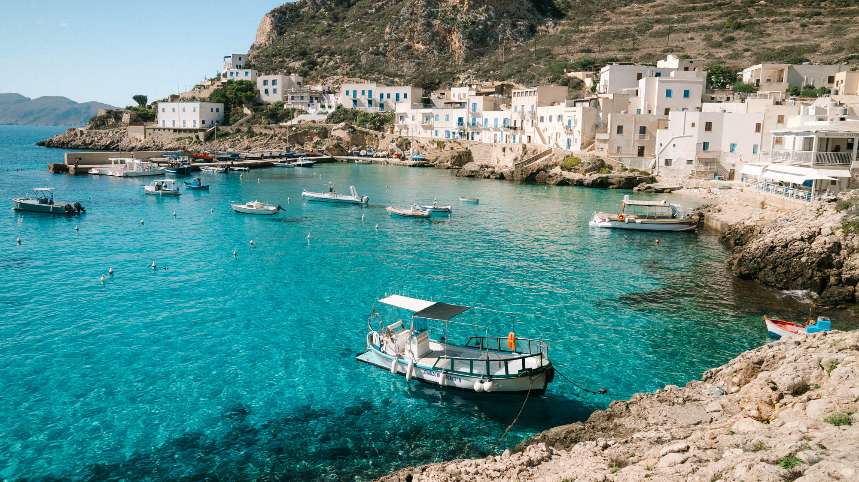
Sicily is the largest island in Italy and the Mediterranean, a crossroads of civilizations where Greek temples, Norman cathedrals, Baroque palaces, and active volcanoes all coexist. From Mount Etna’s fiery slopes to golden beaches, bustling markets, and some of the world’s most beloved food, Sicily is both a cultural powerhouse and a natural wonderland.
Best Things to Do in Sicily
- Mount Etna: Europe’s most active volcano. You can hike, take cable cars, or join jeep tours for crater views. At night, glowing lava flows are unforgettable.
- Valley of the Temples (Agrigento): A UNESCO site with well-preserved ancient Greek temples dating back 2,500 years.
- Palermo: The island’s capital, rich in markets like Ballarò and Capo, the Norman Palace, and Palermo Cathedral.
- Taormina: A hilltop town with an ancient Greek theater overlooking the Ionian Sea and Mount Etna.
- Syracuse & Ortigia: A blend of Greek, Roman, and Baroque heritage with lively seaside charm.
- Baroque Cities: Ragusa, Modica, and Noto are stunning examples of Sicilian Baroque architecture.
- Aeolian Islands: Just off Sicily’s coast, perfect for island-hopping (Stromboli, Lipari, Vulcano, and more).
Top Beaches of Sicily
Sicily has a diverse coastline, offering sandy stretches, hidden coves, and dramatic cliffs:
- San Vito Lo Capo: White sands and Caribbean-blue waters.
- Scala dei Turchi: White limestone cliffs with natural terraces plunging into turquoise seas.
- Cefalù: Golden sand beach beneath a medieval town and Norman cathedral.
- Isola Bella (Taormina): A tiny island connected to the shore by a sandy isthmus, ideal for snorkeling.
- Vendicari Nature Reserve: Wild, unspoiled beaches near Noto.
Food and Drink options in Sicily
Sicilian cuisine is legendary, blending Italian, Greek, Arab, and Spanish influences:
- Arancini: Fried rice balls stuffed with ragù, cheese, or pistachio.
- Pasta alla Norma: Pasta with eggplant, tomato, ricotta salata, and basil.
- Caponata: A sweet-and-sour eggplant dish.
- Granita with Brioche: A refreshing Sicilian breakfast, especially in summer.
- Cannoli: Crispy pastry shells filled with ricotta cream.
- Seafood Couscous: Especially in western Sicily, showing North African influence.
Pair meals with local wines: Nero d’Avola, Etna Rosso, or the dessert wine Marsala.
How to Get to Sicily?
- By Air: Main airports are Palermo (PMO), Catania (CTA), and Trapani (TPS), with flights from Italy and Europe.
- By Ferry: Ferries connect Sicily to Naples, Genoa, Civitavecchia, and Sardinia.
- By Train: Trains run from mainland Italy, with carriages ferried across the Strait of Messina.
Suggested Itinerary for Sicily(7–10 Days)
- Day 1–2: Explore Palermo’s historic markets, churches, and palaces.
- Day 3: Visit the Valley of the Temples in Agrigento.
- Day 4–5: Stay in Taormina, visit the Greek Theater, and hike or tour Mount Etna.
- Day 6: Explore Syracuse and Ortigia Island.
- Day 7: Discover the Baroque towns of Ragusa, Noto, and Modica.
- Day 8–9: Relax at San Vito Lo Capo or Scala dei Turchi.
- Day 10 (Optional): Take a boat to the Aeolian Islands for volcanoes and thermal spas.
Sicily is the ultimate all-rounder island in Italy — blending ancient history, fiery volcanoes, world-class food, and stunning beaches. It’s a journey into both the soul of Italy and the heart of the Mediterranean.
3. Capri – The Glamorous Island of the Bay of Naples
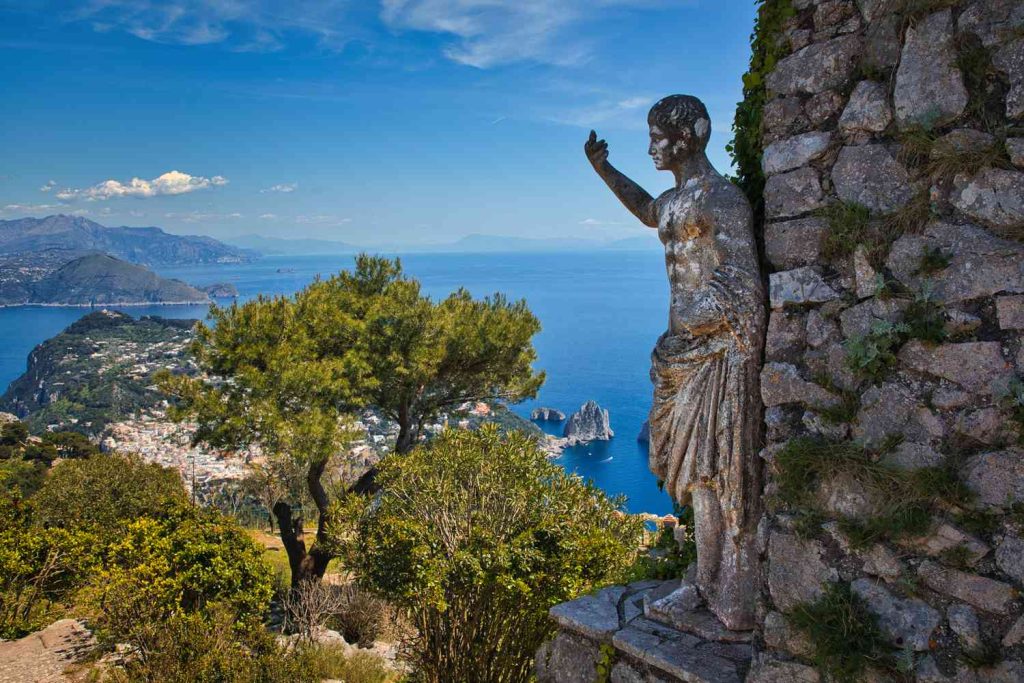
Few Italian islands are as famous as Capri, a jewel in the Bay of Naples known for its Hollywood glamour, dramatic cliffs, luxury shopping, and legendary Blue Grotto. Once a Roman emperor’s retreat and now a playground for celebrities, Capri combines natural wonders with high-end sophistication. Despite its reputation for luxury, it’s also a place where day-trippers and nature lovers can find magic in its landscapes.
Best Things to Do in Capri
- Blue Grotto (Grotta Azzurra): A sea cave where sunlight creates glowing blue waters — Capri’s most iconic sight. Accessible by small boats.
- Piazzetta di Capri: The heart of the island, filled with cafes, designer boutiques, and people-watching opportunities.
- Villa Jovis: The ruins of Emperor Tiberius’s Roman villa, perched dramatically on cliffs.
- Augustus Gardens (Giardini di Augusto): With panoramic views of the Faraglioni rock formations and Via Krupp.
- Monte Solaro: Take the chairlift from Anacapri for sweeping views over the Bay of Naples and Amalfi Coast.
- Anacapri: A quieter town with artisan shops, local restaurants, and fewer crowds.
- Luxury Shopping: Capri is home to some of Italy’s most exclusive boutiques, from high fashion to handcrafted sandals.
Top Beaches and Swimming Spots in Capri
Capri is more about rocky coves than sandy beaches, but its waters are spectacular:
- Marina Piccola: A popular spot with views of the Faraglioni.
- Bagni di Tiberio: A beach club with Roman ruins along the shoreline.
- Faraglioni Rocks: Swim or take a boat tour through the famous arch.
- Private Beach Clubs: Like La Fontelina or Il Riccio, where you can relax in style.
Food and drink options in Capri
Capri’s cuisine reflects Mediterranean simplicity with luxury flair:
- Insalata Caprese: The famous salad of mozzarella, tomatoes, and basil, born here.
- Spaghetti alla Nerano: Pasta with zucchini, cheese, and basil.
- Fresh Seafood: Grilled octopus, lobster, and anchovies.
- Torta Caprese: A rich chocolate and almond cake, a local specialty.
Pair meals with crisp Campania wines like Falanghina or Greco di Tufo.
How to Get There?
- By Ferry/Hydrofoil: Regular services from Naples, Sorrento, Amalfi, and Positano (40–80 minutes).
- By Private Boat: Many luxury travelers charter yachts to Capri.
- By Air: Closest airport is Naples; transfer to the port for ferries.
Suggested Itinerary (2–3 Days)
- Day 1: Arrive by ferry, explore the Piazzetta, stroll through the Augustus Gardens, and take a sunset boat trip around the island.
- Day 2: Visit the Blue Grotto early, then head to Anacapri to take the chairlift up Monte Solaro. Relax in the afternoon at a beach club.
- Day 3 (Optional): Hike along Via Krupp or to Villa Jovis, then enjoy shopping and a final seafood dinner overlooking the sea.
Capri is glamour meets nature — a place where Roman history, celebrity luxury, and Mediterranean beauty all come together. Whether you’re sipping limoncello in a piazza or sailing beneath the Faraglioni, Capri is unforgettable.
4. Ischia – The Island of Thermal Spas and Gardens
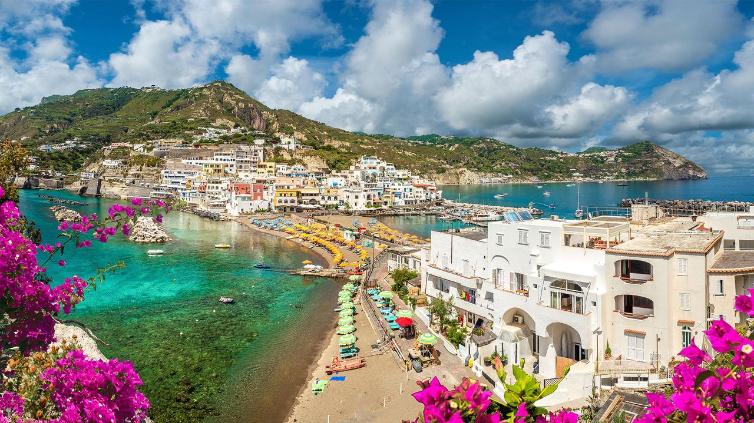
Just across the bay from Capri lies Ischia, the largest of the Phlegraean Islands, often called the “green island” thanks to its lush vegetation and volcanic origins. While Capri is known for glamour, Ischia is about wellness, relaxation, and authenticity. With its thermal hot springs, sandy beaches, historic castles, and lush gardens, it’s a favorite for Italians but still feels less touristy than its famous neighbor.
Best Things to Do in Ischia
- Castello Aragonese: A medieval castle perched dramatically on a rocky islet connected to the town of Ischia Ponte by a causeway. Inside, you’ll find chapels, gardens, and sweeping views.
- Thermal Spas & Hot Springs: Ischia’s volcanic soil makes it one of Europe’s top spa destinations. Famous resorts include Negombo and Poseidon Gardens, offering pools of different temperatures and therapeutic mud baths.
- La Mortella Gardens: A lush botanical garden created by Susana Walton, wife of British composer William Walton. It’s home to rare plants, fountains, and music performances.
- Sant’Angelo: A picturesque fishing village with pastel houses, pedestrian alleys, and chic cafes.
- Monte Epomeo: The highest point on the island, perfect for hiking and panoramic views.
- Wine Tasting: Ischia’s volcanic soil produces unique wines; try Biancolella and Forastera whites.
Top Beaches
Unlike rocky Capri, Ischia has more sandy beaches, making it great for families:
- Maronti Beach: The longest beach on the island, with hot springs bubbling right under the sand.
- Citara Beach: Near Poseidon Thermal Gardens, with golden sands and clear waters.
- San Montano Bay: A sheltered, family-friendly bay with calm waters.
- Cartaromana Beach: Overlooked by Castello Aragonese, with thermal springs in the sea.
Food and Drink
Ischia’s cuisine blends seafood and rustic island traditions:
- Coniglio all’Ischitana (Ischia-style Rabbit): A signature dish cooked with white wine, garlic, and herbs.
- Spaghetti alle Cozze: Pasta with mussels, garlic, and tomato.
- Zingara Sandwich: A local street-food sandwich with ham, mozzarella, and tomatoes.
- Ischia Lemons: Used in refreshing drinks and desserts.
Pair your meals with local white wines, perfect for seafood and summer evenings.
How to Get There?
- By Ferry/Hydrofoil: From Naples (60–90 minutes) or Pozzuoli. Hydrofoils also run from Capri and Sorrento.
- By Air: Naples International Airport is the closest, with connections to ferries.
Suggested Itinerary (3–4 Days)
- Day 1: Arrive and explore Ischia Ponte, including Castello Aragonese. Evening stroll along the waterfront.
- Day 2: Spend the day at Poseidon Gardens or Negombo Thermal Park, soaking in hot pools and enjoying sea views.
- Day 3: Visit La Mortella Gardens in the morning, relax on San Montano Bay, and enjoy a seafood dinner in Sant’Angelo.
- Day 4 (Optional): Hike Monte Epomeo for panoramic views, then wind down with a wine tasting before departure.
Ischia is the wellness capital of Italian islands — where you can soak in hot springs, wander ancient castles, and relax on sandy beaches. It’s the ideal mix of healing, history, and seaside charm.
5. Procida – Italy’s Colorful Island Gem
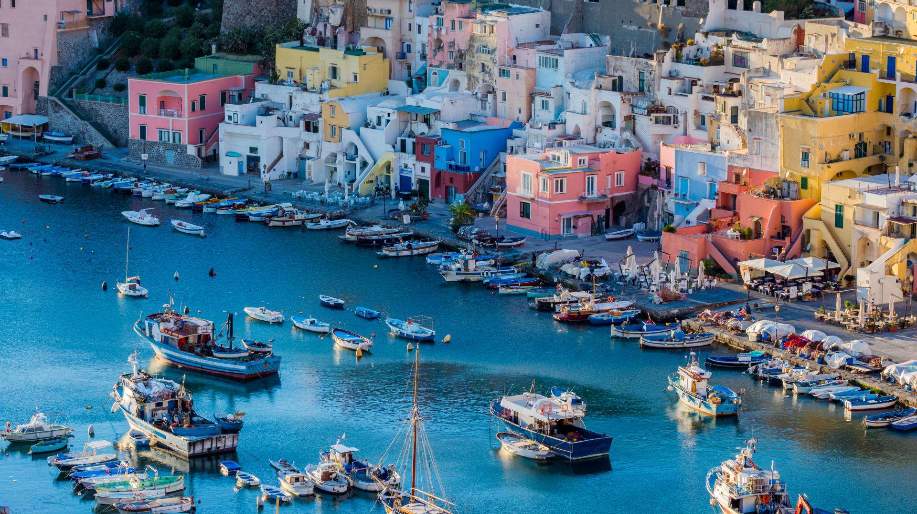
Often overshadowed by its larger neighbors Capri and Ischia, Procida is a small island in the Bay of Naples bursting with charm, authenticity, and color. With its pastel-painted fishing villages, cobblestone alleys, and slow pace of life, Procida feels like stepping into a Mediterranean postcard. Named Italy’s Capital of Culture in 2022, it has since gained global attention while still retaining its laid-back vibe. For travelers in 2025, Procida is the perfect island for those seeking authenticity, romance, and vibrant beauty without the heavy crowds.
Best Things to Do in Procida
- Marina Corricella: The island’s iconic fishing village, with pastel houses tumbling down to the sea. A must for photography, seaside dining, and leisurely strolls.
- Terra Murata: The historic hilltop citadel with medieval walls, panoramic views, and the former Palazzo d’Avalos prison.
- Cultural Trails: Procida has been a muse for literature and cinema. It’s featured in The Talented Mr. Ripley and Il Postino; fans can explore filming locations.
- Boat Tours: Circumnavigate the island by boat to discover hidden caves, cliffs, and coves.
- Church of Santa Maria delle Grazie: A striking yellow Baroque church overlooking Marina Corricella.
Top Beaches
Procida may be small, but it boasts some enchanting seaside escapes:
- Spiaggia di Chiaiolella: A long sandy beach backed by cafes and perfect for sunsets.
- Spiaggia di Pozzo Vecchio (The Postman’s Beach): Featured in Il Postino, with golden sand and dramatic cliffs.
- Spiaggia della Lingua: Near Marina Grande, good for swimming and convenience.
- Ciraccio Beach: Separated from Chiaiolella by rocky sea stacks, quieter and scenic.
Food and Drink
Procida’s cuisine is deeply tied to its fishing heritage and lemon groves:
- Lingua di Procida: A puff pastry dessert filled with lemon cream — iconic and unmissable.
- Spaghetti ai Ricci di Mare: Pasta with fresh sea urchins, showcasing the island’s maritime flavors.
- Coniglio alla Cacciatora: A rustic rabbit stew found inland.
- Limoncello & Lemon Granita: Procida’s lemons are smaller and more aromatic than Amalfi’s, used in refreshing drinks and desserts.
How to Get There?
- By Ferry/Hydrofoil: From Naples (about 40 minutes by hydrofoil or 1 hour by ferry), Pozzuoli, or Ischia.
- By Air: Fly into Naples International Airport, then transfer to the port.
Suggested Itinerary (2–3 Days)
- Day 1: Stroll Marina Corricella, have lunch overlooking the harbor, and visit Santa Maria delle Grazie.
- Day 2: Morning hike to Terra Murata, explore Palazzo d’Avalos, then relax at Pozzo Vecchio beach in the afternoon.
- Day 3 (Optional): Take a boat tour around the island, stopping at hidden coves, then finish with a lemon dessert and sunset at Chiaiolella.
Procida is Italy’s island of colors and culture — charming, authentic, and romantic. For travelers looking for a true slice of Italian island life in 2025, it’s a must-see.
6. Elba – Napoleon’s Exile and Beaches
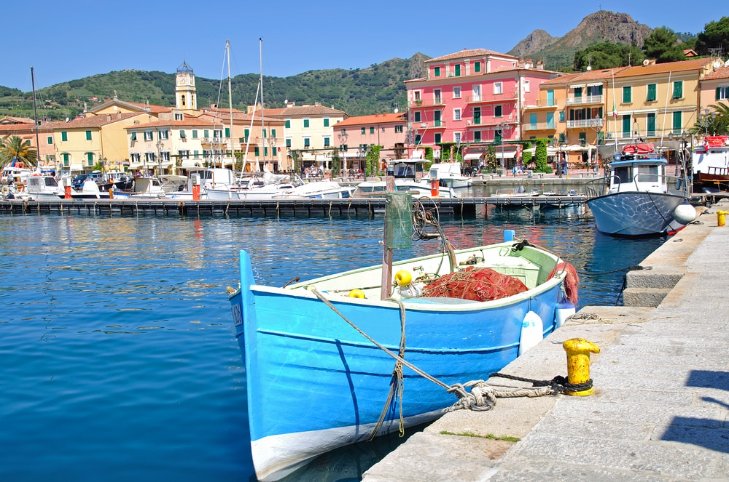
Elba, the largest island in the Tuscan Archipelago, is famous as the place where Napoleon Bonaparte was exiled in 1814. But today, travelers know it more for its stunning beaches, crystal-clear waters, and charming towns. With a mix of history, culture, and seaside relaxation, Elba offers one of the best island getaways in Italy.
Best Things to Do in Elba
- Napoleon’s Villas: Visit Villa dei Mulini in Portoferraio (his official residence) and Villa San Martino, his summer retreat. Both offer insight into the emperor’s life during exile.
- Monte Capanne: Take the cable car (a thrilling open-air basket ride) or hike to the summit for panoramic views across the archipelago.
- Portoferraio: The island’s capital, full of pastel houses, fortresses, and lively piazzas.
- Marciana Marina: A quaint seaside town perfect for evening strolls and seafood dinners.
- Wine Routes: Elba produces excellent Aleatico wine — a sweet red perfect for dessert.
Top Beaches
- Fetovaia Beach: A crescent-shaped sandy beach with calm waters, great for families.
- Cavoli Beach: Popular with younger crowds for its vibrant beach scene and turquoise sea.
- Biodola Beach: One of the longest sandy stretches, lined with resorts.
- Sansone Beach: Famous for its white pebbles and crystal waters — ideal for snorkeling.
Food and Drink
Elba’s cuisine is simple, fresh, and sea-inspired:
- Stoccafisso alla Riese: A codfish dish with potatoes and olives.
- Zuppa di Pesce (Fish Soup): Local fishermen’s specialty.
- Schiaccia Briaca: A traditional raisin-and-nut cake originally made without alcohol, now enriched with Aleatico wine.
- Pair meals with Elba DOC wines, especially whites like Vermentino.
How to Get There?
- By Ferry: The main gateway is Piombino (Tuscany). Ferries and hydrofoils run frequently to Portoferraio, Cavo, and Rio Marina. The trip takes 40–60 minutes.
- By Air: Small seasonal airport in Marina di Campo with connections to mainland Italy and Europe.
Suggested Itinerary (3–4 Days)
- Day 1: Arrive in Portoferraio, visit Napoleon’s Villa dei Mulini, and enjoy dinner by the harbor.
- Day 2: Relax on Fetovaia Beach and explore Marciana Marina in the evening.
- Day 3: Hike or take the cable car up Monte Capanne, then spend the afternoon snorkeling at Sansone Beach.
- Optional Day 4: Visit the island’s wine estates and try Aleatico wines.
7. Aeolian Islands – Volcanic Wonders
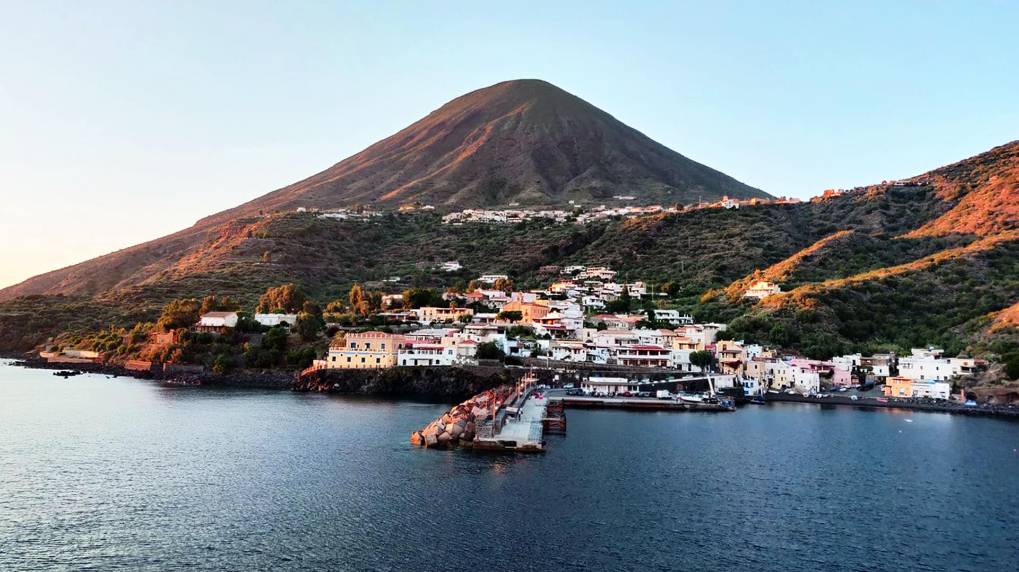
North of Sicily, scattered across the Tyrrhenian Sea, lies the Aeolian Archipelago — seven volcanic islands that are so unique they’ve been designated a UNESCO World Heritage Site. Each island has its own personality: some fiery and wild, others tranquil and green, but all sharing dramatic landscapes, black-sand beaches, and a fascinating mix of culture and geology.
The seven islands are Lipari, Vulcano, Stromboli, Salina, Panarea, Filicudi, and Alicudi. Together, they make one of the best places in Italy for adventurous travelers, divers, and those who enjoy island-hopping.
Best Things to Do in the Aeolian Islands
- Lipari – The Heart of the Aeolians: Visit the Lipari Castle and Archaeological Museum, stroll along the lively Corso Vittorio Emanuele, and enjoy local shops and bars.
- Vulcano – Mud Baths & Sulfur Springs: Take a therapeutic soak in natural mud baths and hike up Gran Cratere for breathtaking views.
- Stromboli – Living Volcano: Experience an evening hike or boat tour to see fiery eruptions from the “Sciara del Fuoco” (Stream of Fire).
- Salina – Green Paradise: Known for vineyards and caper fields, Salina is the island of Malvasia wine and hiking trails.
- Panarea – Jet-Set Charm: Chic and glamorous, with whitewashed houses, boutique hotels, and upscale nightlife.
- Filicudi & Alicudi – Wild and Remote: Ideal for those seeking peace, with untouched nature, old mule tracks, and pristine waters.
Top Beaches
- Spiaggia Bianca (Lipari): A dazzling beach made of white pumice stone.
- Spiaggia di Sabbie Nere (Vulcano): Famous black-sand beach with thermal waters nearby.
- Scoglio di Basiluzzo (Panarea): Great for diving and boat excursions.
Food and Drink
The Aeolians are a food lover’s dream. Look out for:
- Caponata alla Eoliana – sweet-and-sour eggplant dish.
- Pasta alla Norma – pasta with tomatoes, eggplant, and ricotta salata.
- Granita & Brioche – the perfect summer breakfast.
- Capers from Salina – exported worldwide and used in many dishes.
How to Get There?
- From Sicily: Regular ferries and hydrofoils run from Milazzo, Messina, and Palermo.
- From Naples: Overnight ferries connect to Lipari, Stromboli, and other islands.
- Around the islands: Hydrofoils make inter-island travel easy, so island-hopping is a must.
Suggested Itinerary (5–6 Days)
- Day 1–2: Stay on Lipari, visit the museum, and take a day trip to Vulcano.
- Day 3: Head to Stromboli for a night volcano hike.
- Day 4: Relax in Salina, sample capers and Malvasia wine.
- Day 5: Explore chic Panarea.
- Optional Day 6: Venture further to remote Filicudi or Alicudi.
8. Ponza – The Secret Getaway of Romans
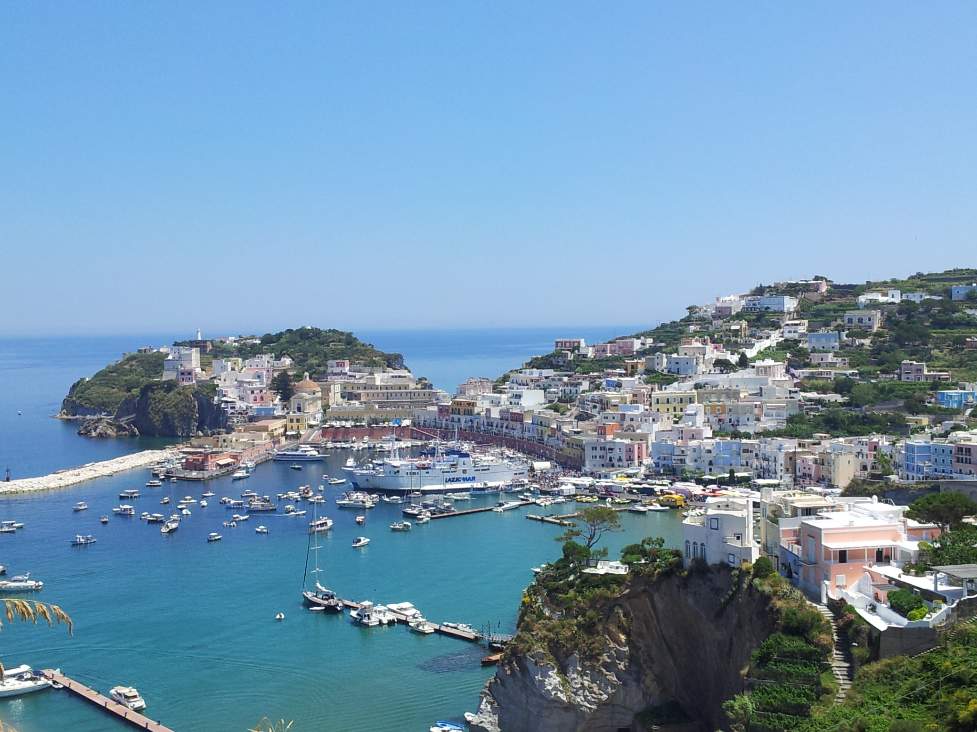
Just a few hours from Rome, Ponza is one of Italy’s best-kept secrets. While international travelers flock to Capri and Ischia, Italians in the know escape to Ponza for its crystal-clear waters, hidden grottoes, and laid-back charm. With pastel-colored houses hugging the harbor, dramatic cliffs plunging into the sea, and coves accessible only by boat, Ponza feels both glamorous and authentic.
Best Things to Do in Ponza
- Explore the Grottos by Boat: Hire a boat or join a guided tour to see natural wonders like the Grotte di Pilato, ancient Roman fish ponds carved into the cliffs.
- Chiaia di Luna: The island’s most famous beach, a crescent of golden sand backed by towering white cliffs. (Currently closed due to rockfalls, but stunning even from above.)
- Cala Feola & Natural Pools: Swim in volcanic rock pools carved by the sea, a favorite for families.
- Harbor Stroll (Porto di Ponza): Lined with pastel houses, boutique shops, and seafood restaurants — perfect for an evening passeggiata.
- Hike to Punta Incenso: A rewarding trail with sweeping views of the coastline and neighboring islands.
Top Beaches
- Frontone Beach: The most popular beach, accessible by water taxi from the port. Lively atmosphere, beach bars, and clear waters.
- Cala Felci: Known for its green clay, which locals use for DIY spa treatments.
- Cala dell’Acqua: Great for snorkeling, with ruins of an old Roman mine nearby.
Food and Drink
Ponza’s cuisine is rooted in the sea. Don’t miss:
- Spaghetti ai Ricci di Mare: Pasta with fresh sea urchin.
- Calamari Ripieni: Stuffed squid, often with breadcrumbs and herbs.
- Tielle Ponzese: A savory pie filled with octopus or other seafood.
Pair meals with crisp Lazio white wines like Falanghina or Biancolella.
How to Get There?
- By Ferry/Hydrofoil: Ferries depart from Anzio, Formia, Terracina, and Naples. In summer, hydrofoils are the fastest option (about 75–120 minutes).
- By Car + Ferry: Travelers often drive to the Lazio coast, park, and take the ferry across.
Suggested Itinerary (2–3 Days)
- Day 1: Arrive at Porto di Ponza, enjoy seafood by the harbor, and relax at Frontone Beach.
- Day 2: Boat tour around the island — explore grottoes, swim in Cala Feola’s natural pools, and admire Chiaia di Luna from the cliffs.
- Day 3 (Optional): Hike Punta Incenso for panoramic views, then take a leisurely lunch before your ferry back.
Ponza is where Rome’s elite come to unwind — chic but not flashy, authentic but comfortable. It’s the perfect blend of natural beauty, culinary delights, and quiet sophistication.
9. Giglio – A Tuscan Island Treasure
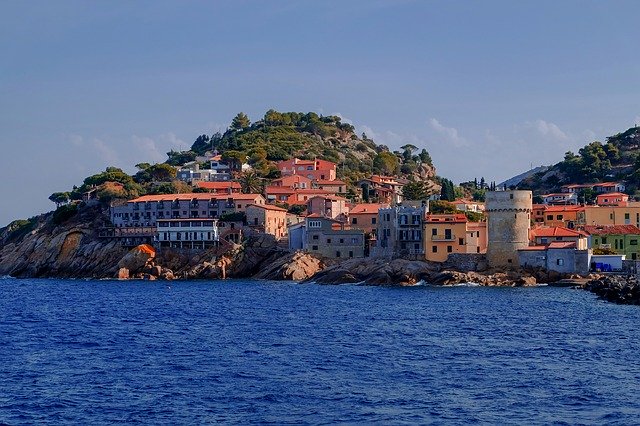
Part of the Tuscan Archipelago, the island of Giglio is a hidden gem most travelers overlook in favor of Elba. But those who make the trip discover an island of crystal-clear waters, medieval hilltop villages, scenic hiking trails, and authentic Tuscan flavors. It’s small (just 17 square miles) but packs in a variety of experiences — from lazy beach days to history-rich explorations.
Best Things to Do in Giglio
- Explore Giglio Castello: A medieval fortress town perched high on a hill, with narrow cobblestone alleys, stone walls, and panoramic views. Don’t miss the Rocca Aldobrandesca, an ancient fortress.
- Discover Giglio Porto: The colorful harbor town where ferries arrive. Great for seaside dining, shopping, and evening strolls.
- Hiking Trails: Trek across the island’s rugged terrain, especially the trail from Giglio Castello to Campese for breathtaking sea views.
- Wine Tasting: Giglio is famous for Ansonaco wine, a golden-hued white grown on terraced vineyards clinging to steep cliffs.
- Scuba Diving & Snorkeling: The island is known for its rich underwater life — groupers, barracudas, and coral reefs.
Top Beaches
- Campese Beach: The island’s largest beach, framed by red cliffs and the striking
- Faraglione rock stack. Great for water sports and sunsets.
- Cannelle Beach: A sandy, family-friendly beach close to Giglio Porto.
- Caldane Beach: A small, secluded cove accessible only by footpath or boat — ideal for those seeking privacy.
Food and Drink
Giglio’s cuisine blends Tuscan traditions with Mediterranean seafood. Try:
- Spaghetti alle Vongole: Pasta with clams, fresh from local waters.
- Cacciucco: A rich Tuscan fish stew.
- Totani Ripieni: Stuffed squid, a local specialty.
Pair meals with a glass of Ansonaco wine, still made in traditional ways by local vintners.
How to Get There?
- By Ferry: The only way to reach Giglio is by ferry from Porto Santo Stefano in southern Tuscany. The trip takes about 1 hour and arrives in Giglio Porto.
- By Car/Train + Ferry: Many travelers drive or take the train to Porto Santo Stefano, then hop on the ferry.
Suggested Itinerary (2–3 Days)
- Day 1: Arrive at Giglio Porto, wander the waterfront, and swim at Cannelle Beach.
- Day 2: Spend the morning in Giglio Castello, then hike to Campese Beach for a sunset swim.
- Day 3 (Optional): Take a boat trip around the island, stopping at hidden coves and snorkeling spots.
Giglio is perfect for travelers seeking a mix of Tuscan history, unspoiled beaches, and authentic local culture — all on an island that feels untouched by mass tourism.
10. Maddalena Archipelago – Sailing Paradise
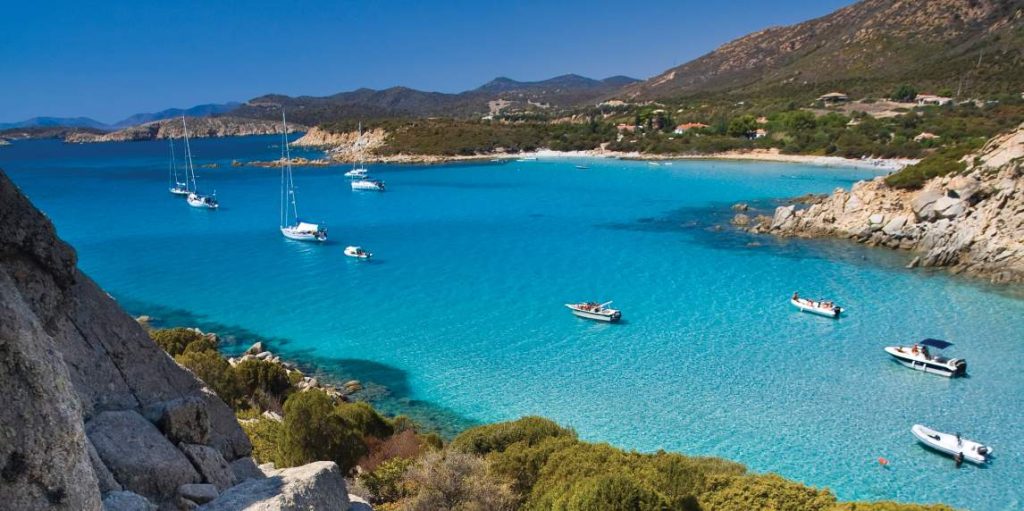
Just off the northern coast of Sardinia, the Maddalena Archipelago is a cluster of over 60 islands and islets, famous for their crystal-clear waters, granite rock formations, and hidden coves. Protected as a national park, this UNESCO-listed archipelago is considered one of the best sailing destinations in the Mediterranean.
The seven main islands are La Maddalena, Caprera, Spargi, Budelli, Santa Maria, Razzoli, and Santo Stefano — each offering something different for travelers.
Best Things to Do in the Maddalena Archipelago
- La Maddalena Town: Wander through the pastel-colored streets, shop for handmade crafts, and enjoy waterfront dining.
- Caprera Island: Known for its unspoiled nature and as the final home of Italian hero Giuseppe Garibaldi. Visit the Garibaldi Compendium, his house museum.
- Sailing & Island-Hopping: Charter a yacht or join a boat excursion to explore multiple islands in one day — the only way to see the most remote beaches.
- Snorkeling & Diving: The archipelago’s marine park is rich with colorful fish, sea turtles, and dramatic underwater rock formations.
- Hiking: Trails on Caprera and La Maddalena lead to scenic lookouts with breathtaking views of the turquoise sea.
Top Beaches
- Spiaggia Rosa (Budelli): Famous “Pink Beach,” once open to the public but now protected. Visitors can admire it from a distance.
- Cala Coticcio (Caprera): Nicknamed “Tahiti” for its shallow, turquoise waters and powdery sand.
- Cala Granara (Spargi): A pristine, tropical-looking beach accessible only by boat.
- Bassa Trinita (La Maddalena): A family-friendly beach with soft sand and shallow water.
Food and Drink
While small, the islands offer authentic Sardinian flavors:
- Culurgiones: Sardinian stuffed pasta with potato and mint.
- Porceddu: Roasted suckling pig, a regional specialty.
- Seadas: Sweet pastries filled with cheese and honey.
Pair with a chilled glass of Vermentino di Gallura, the region’s famous white wine.
How to Get There?
- From Sardinia: Ferries run frequently from Palau (northern Sardinia) to La Maddalena. The trip takes just 15 minutes.
- Around the islands: The best way is by private boat, yacht charter, or organized tour, since many beaches are only accessible by sea.
Suggested Itinerary (3–4 Days)
- Day 1: Explore La Maddalena town, then relax at Bassa Trinita Beach.
- Day 2: Take a boat tour to Budelli, Spargi, and Santa Maria — snorkel and swim in turquoise coves.
- Day 3: Spend the day on Caprera — hike to Cala Coticcio and visit Garibaldi’s house museum.
- Day 4 (Optional): Charter a private boat for a full-day sailing adventure, stopping at hidden beaches only accessible by sea.
With its Caribbean-like waters, hidden coves, and rich history, the Maddalena Archipelago is a dream for sailors, nature lovers, and beach seekers alike.
11. Pantelleria – The Black Pearl of the Mediterranean
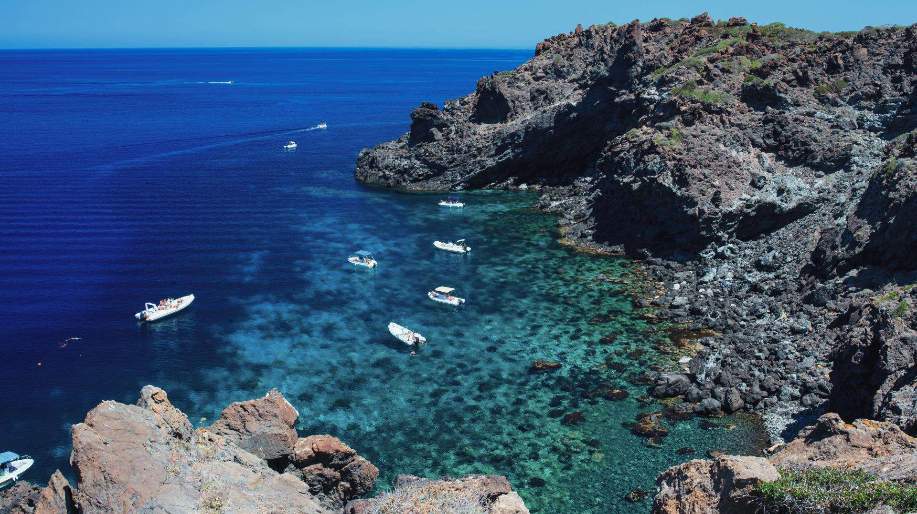
Lying halfway between Sicily and Tunisia, Pantelleria feels like nowhere else in Italy. Known as the “Black Pearl of the Mediterranean”, this volcanic island is a striking mix of rugged lava landscapes, natural hot springs, ancient stone houses, and crystal-clear seas. Remote and wild, Pantelleria offers an off-the-beaten-path adventure for travelers seeking authenticity and raw natural beauty.
Best Things to Do in Pantelleria
- Specchio di Venere (Venus’s Mirror): A stunning natural lake in an extinct volcanic crater, with thermal waters and mud baths said to have therapeutic and beauty benefits.
- Hot Springs & Saunas: Relax in natural saunas hidden in caves, such as the Sataria Caves, which according to legend were used by Ulysses and Calypso.
- Arco dell’Elefante: A natural lava arch dipping into the sea, one of the island’s most iconic landmarks.
- Pantelleria National Park: Explore hiking trails through rugged volcanic terrain, vineyards, and ancient archaeological sites.
- Dammusi Houses: Traditional white-domed stone houses unique to Pantelleria — many have been converted into boutique stays.
- Diving & Snorkeling: The rocky coastline and marine reserves make for spectacular underwater adventures.
Top Beaches and Swimming Spots
Pantelleria doesn’t have sandy beaches — instead, it offers dramatic rocky coves and natural swimming pools:
- Cala Levante & Cala Tramontana: Twin coves perfect for sunbathing and swimming.
- Laghetto delle Ondine: A natural seawater pool carved into the rock.
- Martingana & Balata dei Turchi: Remote, wild coves with dramatic volcanic backdrops.
Food and Drink
Pantelleria’s cuisine blends Italian and North African influences due to its location:
- Couscous di Pesce: A Sicilian-North African dish made with fish broth and semolina.
- Capers di Pantelleria: Famous worldwide, these capers are PDO-certified and add a punch of flavor to salads, pasta, and seafood.
- Passito di Pantelleria: A sweet dessert wine made from sun-dried Zibibbo grapes, one of Italy’s most prized wines.
- Pesce alla Pantesca: Fresh fish baked with tomatoes, olives, capers, and herbs.
How to Get There?
- By Air: Flights from Palermo, Catania, Trapani, and mainland Italy (Rome, Milan, Naples). In summer, there are direct connections from several European cities.
- By Ferry: Overnight ferries run from Trapani (Sicily), taking about 5–6 hours.
Suggested Itinerary (3–4 Days)
- Day 1: Relax at Specchio di Venere and enjoy a natural mud bath.
- Day 2: Explore Arco dell’Elefante and swim in the Laghetto delle Ondine. In the evening, taste Passito wine at a local vineyard.
- Day 3: Hike in Pantelleria National Park, visit the archaeological site of Sesi (ancient stone tombs), and enjoy a seafood dinner.
- Day 4 (Optional): Take a boat trip around the island, discovering hidden coves and snorkeling spots.
Pantelleria is wild, exotic, and unforgettable. With its volcanic landscapes, natural spas, and unique cultural blend, it’s a destination unlike any other Italian island — perfect for travelers seeking something bold and different in 2025.
12. Lampedusa – The Caribbean of Italy
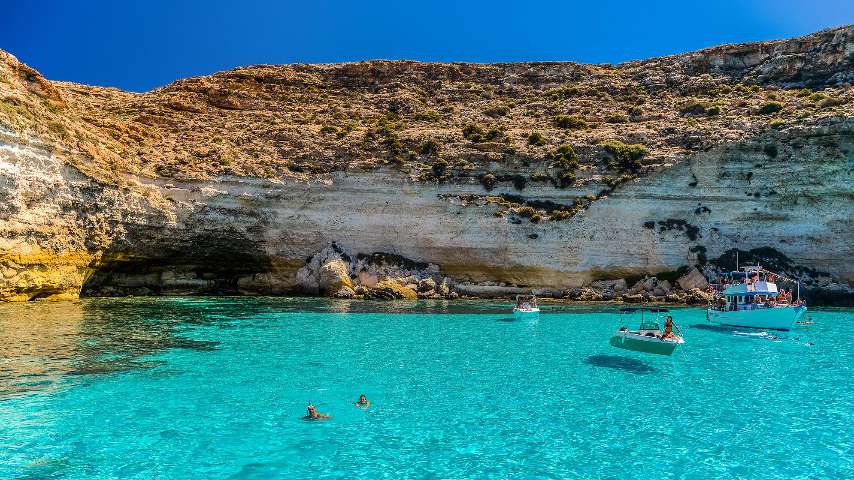
Closer to Africa than mainland Italy, Lampedusa is the southernmost point of Italy and part of the Pelagie Islands. Known for its white sandy beaches, turquoise waters, and protected marine life, Lampedusa is often compared to the Caribbean. It’s remote, wild, and breathtakingly beautiful — an island where days revolve around the sea.
Best Things to Do in Lampedusa
- Spiaggia dei Conigli (Rabbit Beach): Consistently voted one of the world’s best beaches. Its powdery white sand and crystal-clear shallows make it look like paradise. Loggerhead turtles also come here to nest.
- Snorkeling & Diving in the Marine Reserve: Lampedusa’s waters are part of a protected marine area. Expect to see dolphins, turtles, and colorful fish.
- Isola dei Conigli (Rabbit Island): A small islet off the coast, accessible by swimming in shallow waters.
- Glass-Bottom Boat Tours: Perfect for travelers who want to see underwater wonders without diving.
- Explore Cala Creta & Cala Pulcino: Stunning rocky coves for swimming and sunbathing.
- Evening in the Town Center: The main town offers a relaxed nightlife with bars, trattorias, and gelato shops.
Top Beaches
- Spiaggia dei Conigli: The crown jewel — untouched, protected, and dazzling.
- Cala Madonna: Family-friendly with calm waters.
- Cala Croce: Great for snorkeling and lively beach bars.
- Cala Guitgia: Easily accessible, near the town, with golden sands.
Food and Drink
Lampedusa’s cuisine blends Sicilian and North African flavors:
- Couscous di Pesce: A spicy fish couscous, similar to Tunisia’s version.
- Grilled Swordfish & Tuna: Freshly caught and served with capers and olive oil.
- Arancini: Sicilian rice balls, popular street food.
- Cassata & Cannoli: Classic Sicilian desserts with ricotta filling.
Pair meals with Passito di Pantelleria or local Sicilian wines.
How to Get There?
- By Air: Lampedusa has a small airport with flights from Palermo, Catania, Trapani, and mainland Italy (Rome, Milan, Bologna). In summer, there are direct flights from other European cities.
- By Ferry: Overnight ferries run from Porto Empedocle (Sicily) to Lampedusa. The trip takes about 9–10 hours.
Suggested Itinerary (3–4 Days)
- Day 1: Relax at Spiaggia dei Conigli, swim in the shallow turquoise waters, and watch the sunset.
- Day 2: Take a boat tour around the island, stopping at Cala Pulcino and Cala Creta for snorkeling.
- Day 3: Spend the morning at Cala Croce, then explore the town center for shopping and Sicilian street food.
- Day 4 (Optional): Join a conservation activity, like a turtle release program, or take a glass-bottom boat ride.
Lampedusa is Italy’s Caribbean dream — perfect for beach lovers, divers, and travelers seeking sunshine and turquoise seas far from the crowds.
13. Stromboli – The Island of Fire
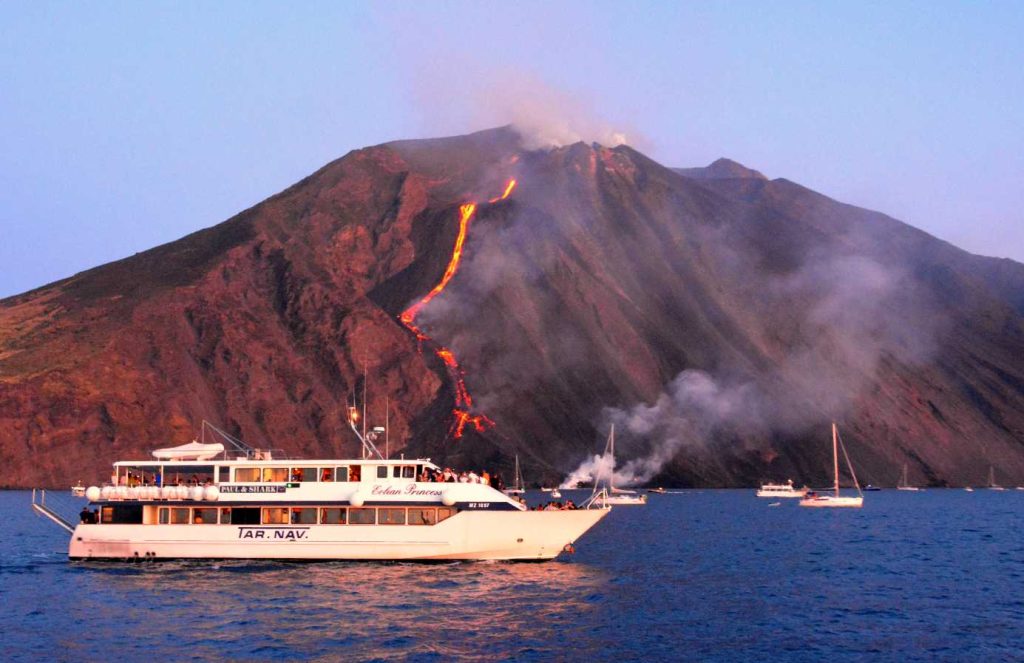
Part of the Aeolian Islands, Stromboli is unlike any other place in Italy. Rising dramatically from the sea, this volcanic island is home to one of the world’s most active volcanoes, which has been erupting continuously for thousands of years. Known as the “Lighthouse of the Mediterranean”, Stromboli offers travelers the thrill of adventure with a raw, natural beauty that feels almost otherworldly.
Best Things to Do in Stromboli
- Hike to the Crater: Guided hikes take adventurous travelers up to Sciara del Fuoco (Stream of Fire), where lava flows down into the sea. The spectacle at sunset or night is unforgettable.
- Boat Tours at Night: Watch glowing eruptions from the sea — a safer and awe-inspiring way to witness nature’s fireworks.
- Strombolicchio Islet: Visit this rocky outcrop just offshore, crowned with a lighthouse. Great for diving and photography.
- Wander Stromboli Village: Whitewashed houses, narrow alleys, and bougainvillea make the town postcard-perfect.
- Ginostra Village: Accessible only by boat, this tiny hamlet offers a step back in time with donkey paths and incredible sea views.
Top Beaches
Stromboli’s beaches are unique with black volcanic sand:
- Spiaggia di Ficogrande: The most popular beach, near the main village, with views of Strombolicchio.
- Spiaggia di Piscità: Quieter than Ficogrande, with dramatic views of lava slopes.
- Ginostra’s Rocky Shores: Secluded spots perfect for those arriving by boat.
Food and Drink
Local cuisine reflects Aeolian flavors with volcanic soil ingredients:
- Aeolian Capers: Often served with fresh tomato salads.
- Pasta alla Strombolana: Pasta with tuna, olives, capers, and tomatoes.
- Pane Cunzato: Traditional Sicilian flatbread topped with anchovies, tomatoes, and olive oil.
- Aeolian Wines: Malvasia delle Lipari, a sweet dessert wine, is a local highlight.
How to Get There?
- By Ferry/Hydrofoil: From Milazzo (Sicily) year-round; from Naples, Messina, or Palermo seasonally.
- By Boat Tours: Many Aeolian Island cruises include Stromboli as a stop.
Suggested Itinerary (2–3 Days)
- Day 1: Explore Stromboli Village, relax at Ficogrande Beach, and enjoy sunset views.
- Day 2: Take a guided volcano hike to Sciara del Fuoco and watch eruptions after dark.
- Day 3 (Optional): Visit Ginostra by boat and swim in hidden coves.
Stromboli is raw, wild, and thrilling. If you’ve ever wanted to see nature’s power up close, this island in Italy delivers an unforgettable adventure.
14. Favignana – The Butterfly of the Egadi Islands
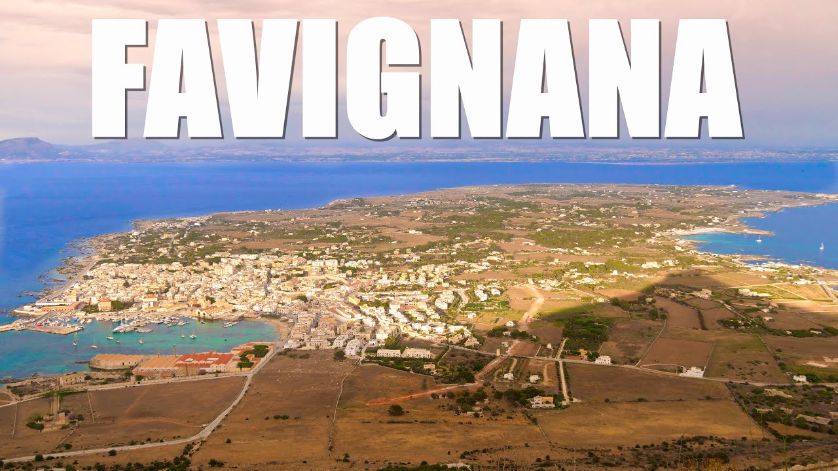
Located just off the western coast of Sicily, Favignana is the largest of the Egadi Islands. Known as the “Butterfly of the Mediterranean” because of its butterfly-shaped outline, Favignana is a laid-back paradise with turquoise waters, tuna-fishing heritage, and slow island charm. Unlike more glamorous Italian islands, Favignana offers an authentic, relaxed experience where days are best spent cycling from one beach to another.
Best Things to Do in Favignana
- Explore the Historic Tonnara (Ex Stabilimento Florio): Once one of the largest tuna canneries in Europe, now a museum telling the story of tuna fishing traditions.
- Cycling Around the Island: The flat terrain makes biking the best way to discover hidden coves and beaches.
- Boat Tours of the Egadi Islands: Visit Levanzo and Marettimo, Favignana’s sister islands, for a full island-hopping experience.
- Castello di Santa Caterina: A hilltop fortress with panoramic views of the island and the Sicilian coast.
- Relax in Favignana Town: Lively piazzas filled with cafes, gelaterias, and local shops.
Top Beaches
Favignana is famed for its crystal-clear coves that resemble natural swimming pools:
- Cala Rossa: One of the most beautiful beaches in Italy, with turquoise water framed by white limestone cliffs.
- Cala Azzurra: A sandy beach ideal for families.
- Bue Marino: Rocky inlets with dramatic cliffs, great for snorkeling and diving.
- Lido Burrone: The island’s most accessible sandy beach with facilities.
Food and Drink
Favignana’s cuisine reflects its tuna-fishing heritage and Sicilian traditions:
- Tonnina di Favignana: Preserved tuna prepared in different ways — grilled, salted, or jarred in olive oil.
- Pasta con Bottarga: Pasta topped with cured tuna roe.
- Granita: Refreshing Sicilian shaved ice, perfect on hot days.
- Cannoli & Cassatelle: Traditional Sicilian sweets filled with ricotta.
Pair meals with a crisp Grillo or Catarratto white wine from Sicily.
How to Get There?
- By Ferry/Hydrofoil: From Trapani (Sicily), hydrofoils take about 30 minutes; ferries about 1 hour.
- By Air: The nearest airport is Trapani-Birgi, with connections to mainland Italy and Europe.
Suggested Itinerary (3 Days)
- Day 1: Arrive and explore Favignana town, then relax at Lido Burrone.
- Day 2: Cycle to Cala Rossa and Bue Marino, stopping for swims along the way. Visit the old tuna factory museum in the afternoon.
- Day 3: Take a boat tour to Levanzo and Marettimo for a day of island-hopping and snorkeling.
With its turquoise waters, tuna heritage, and laid-back pace, Favignana is an ideal island in Italy for travelers who want relaxation mixed with Sicilian authenticity.
15. Ventotene – The Island of History and Tranquility
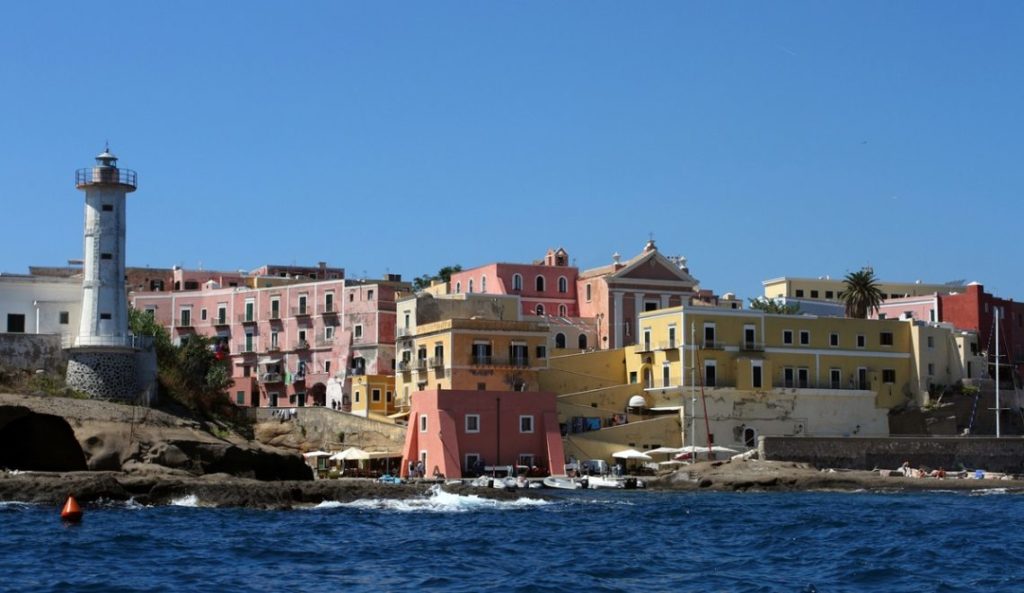
Part of the Pontine Islands in the Tyrrhenian Sea, Ventotene is a small, serene island steeped in history. Once a place of Roman exile and later used by Mussolini to imprison political dissidents, today it offers visitors a mix of archaeology, crystal-clear waters, and a peaceful atmosphere far removed from mass tourism. Ventotene is where you come to slow down, breathe in the sea air, and discover Italy’s quieter side.
Best Things to Do in Ventotene
- Roman Port: Carved directly into volcanic rock, this ancient harbor is still in use today — a marvel of Roman engineering.
- Villa Giulia Ruins: Explore the remains of the Roman emperor Augustus’ villa, where his daughter Julia was exiled.
- Museo Archeologico di Ventotene: Learn about the island’s long history, from Roman times to WWII.
- Snorkeling & Diving: The surrounding marine reserve is rich in biodiversity, with underwater Roman ruins and coral gardens.
- Piazza Castello: The island’s main square, perfect for enjoying a coffee while soaking up local life.
- Boat Excursions: Trips to nearby Santo Stefano Islet, famous for its Bourbon-era prison.
Top Beaches
Ventotene has a rugged coastline with black-sand beaches and rocky coves:
- Cala Nave: The island’s main beach, sandy and close to the town.
- Parata Grande: More secluded, ideal for snorkeling.
- Scoglitello: Small rocky coves accessible by boat.
Food and Drink
Simple, authentic flavors define Ventotene’s cuisine:
- Lentil Soup: The island is famous for its tiny lentils, slow-cooked with herbs and olive oil.
- Spaghetti alle Alici: Pasta with anchovies, garlic, and chili.
- Fresh Seafood: Expect daily catches like squid, octopus, and red mullet.
- Local Pastries: Try “ciambella ventotenese,” a sweet bread flavored with anise.
Pair with Lazio white wines such as Falanghina or Trebbiano.
How to Get There?
- By Ferry/Hydrofoil: From Formia (between Rome and Naples) — ferries take about 2 hours, hydrofoils around 1 hour 15 minutes.
- By Train + Ferry: Travelers from Rome or Naples can take the train to Formia and connect to ferries.
- By Boat Tours: Seasonal connections also exist from Ischia, Naples, and Ponza.
Suggested Itinerary (2–3 Days)
- Day 1: Visit the Roman port, explore the Museo Archeologico, and enjoy a seafood dinner in Piazza Castello.
- Day 2: Take a morning swim at Cala Nave, then join a boat trip to Santo Stefano and tour the old prison.
- Day 3 (Optional): Hike to the Villa Giulia ruins and spend the afternoon snorkeling in the marine reserve.
Ventotene is an island where history meets tranquility. If you want a cultural, low-key Italian island escape, this is the perfect hidden gem.
16. Ustica – The Diver’s Paradise
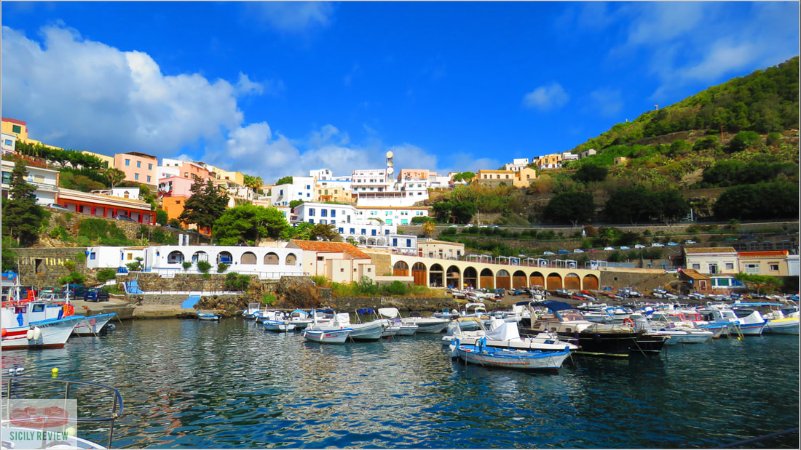
Located about 60 km north of Palermo in Sicily, Ustica is a small volcanic island famous worldwide for its marine reserve. Known as the “Black Pearl of the Mediterranean” because of its volcanic rocks, Ustica is heaven for divers, snorkelers, and nature lovers. With its crystal-clear waters, dramatic sea caves, and unspoiled landscapes, this island offers a unique balance of adventure, serenity, and authentic Sicilian charm.
Best Things to Do in Ustica
- Scuba Diving & Snorkeling: Ustica is Italy’s first marine reserve (established in 1986). With over 30 dive sites, expect coral gardens, underwater caves, and schools of barracuda. Popular spots include Grotta della Pastizza and Punta Galera.
- Boat Excursions: Circle the island to discover caves like Grotta Azzurra (Blue Grotto) and Grotta della Pastizza, with shimmering waters.
- Hiking Trails: Explore paths around the island, such as the trail to Faro Punta Cavazzi, with panoramic sea views.
- Archaeological Museum: Learn about Ustica’s ancient past, with artifacts from Greek and Roman times.
- Wander Ustica Town: A picturesque village with whitewashed houses, colorful murals, and cozy trattorias.
Top Beaches
Ustica’s coastline is rocky rather than sandy, but its coves and clear waters are perfect for swimming:
- Cala Sidoti: A pebbly beach with calm, shallow waters, great for families.
- Cala Giacone: Ideal for snorkeling and cliff diving.
- Piscina Naturale: Natural pools formed in volcanic rock, perfect for a refreshing dip.
Food and Drink
Sicilian traditions shine here, with an emphasis on fresh seafood:
- Lenticchie di Ustica (Ustica Lentils): Tiny, flavorful lentils grown only on the island, used in soups and salads.
- Pasta con i Ricci: Pasta with sea urchins, a local delicacy.
- Grilled Swordfish & Tuna: Caught fresh and prepared simply.
- Cassata Siciliana & Cannoli: Classic Sicilian desserts available in island bakeries.
Pair your meal with a chilled Inzolia or Grillo white wine from Sicily.
How to Get There?
- By Ferry/Hydrofoil: From Palermo, hydrofoils take about 1 hour 30 minutes; ferries about 2 hours 30 minutes.
- By Air: Palermo Airport is the closest international hub. From there, transfer to Palermo port for ferry connections.
Suggested Itinerary (2–3 Days)
- Day 1: Explore Ustica town, enjoy Cala Sidoti, and dine on fresh seafood.
- Day 2: Go diving or snorkeling in the marine reserve, followed by a boat trip to Grotta Azzurra.
- Day 3 (Optional): Hike around the island, visit the archaeological museum, and relax at Piscina Naturale.
Ustica is a hidden treasure for divers and adventurers. If you’re searching for an island in Italy that’s off-the-beaten-path yet bursting with natural wonders, Ustica should top your list.
Ready to Travel Like a VIP?
VIP access to up to 50% off 1M+ hotels & 300K+ activities worldwide. Book like a travel insider — for one low annual price.
Planning your dream Italian island getaway? With RoamVIP, you unlock exclusive savings and insider perks that make every trip more rewarding. Enjoy:
- VIP savings on every trip — up to 10–50% off hotels, activities & more
- First access to flash sales & limited-time offers
- 24/7 travel concierge support for stress-free planning
- No blackout dates — travel when it suits you
- One low annual fee — it pays for itself in just one trip
RoamVIP lets you explore Italy’s most beautiful islands — and beyond — like a true insider, all while keeping your travel budget in check.
FAQs About Visiting Islands in Italy
What is the best time to visit Italian islands?
The ideal time is late spring (May–June) and early fall (September–October). During these months, the weather is pleasantly warm, the sea is perfect for swimming, and popular destinations are less crowded compared to the busy summer peak in July and August.
Which Italian island is the most luxurious?
Capri and Sardinia’s Costa Smeralda are the top choices for luxury seekers. Capri is famous for its chic boutiques, glamorous nightlife, and upscale villas, while Costa Smeralda boasts exclusive resorts, yacht-filled marinas, and a reputation as a playground for the rich and famous.
What island in Italy is the most affordable?
For budget-friendly options, Procida, Favignana, and Ventotene are excellent choices. These islands offer charming guesthouses, reasonably priced local cuisine, and authentic atmospheres without the heavy price tags found on more touristy islands.
Can you island-hop in Italy?
Absolutely! Island-hopping is a highlight of Italian travel. The Aeolian Islands near Sicily and the Tuscan Archipelago off the coast of Tuscany are particularly well-suited, thanks to frequent ferry connections that make exploring multiple islands in a single trip easy and enjoyable.
How many islands does Italy have?
Italy has over 450 islands in total, but only around 80 are inhabited. Each inhabited island has its own unique character, ranging from lively resort destinations to quiet fishing communities, giving travelers a wide variety of experiences to choose from.
Final Thoughts
Italy’s islands are as diverse as the country itself. From the volcanic fire of Stromboli to the luxury of Capri, from the quiet charm of Procida to the Caribbean waters of Lampedusa, every island tells a story.
In 2025, whether you’re seeking romance, adventure, relaxation, or culture, these 16 most beautiful islands in Italy offer something unforgettable.


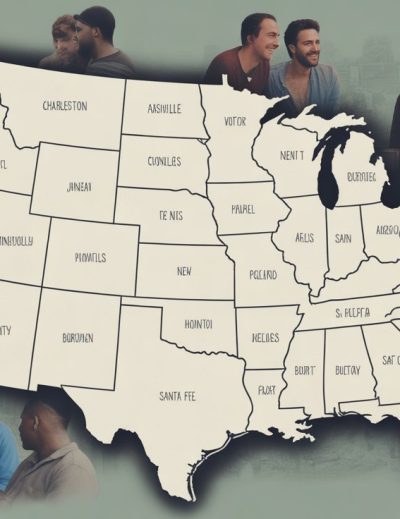
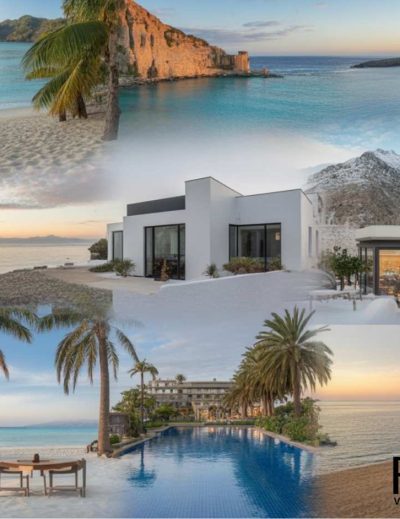
Leave a Reply